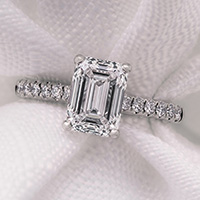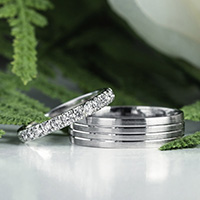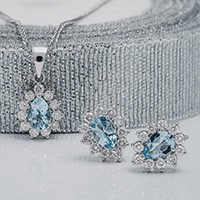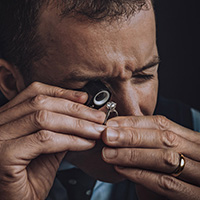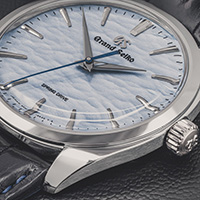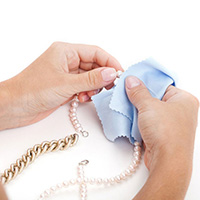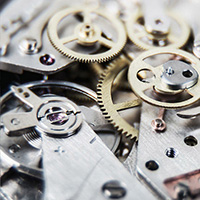- Home/
- Jewellery Care & Cleaning Guide | James Porter & Son
Jewellery Care Guide
In this guide
Why Jewellery care is important
Whether it’s a dazzling showstopper of a necklace, or a ring with a deep sentimental meaning, jewellery is meant to be worn with pride and enjoyed. Daily wear means that these special pieces can come into contact with dirt, chemicals, and solid objects, all of which can affect their appearance and sparkle. Like anything in life, looking after something will make it last longer; jewellery is definitely not an exception to that.
So, we’ve compiled a list of the main metals and gemstones found in modern jewellery and how each reacts to daily wear, what to avoid while wearing them, and how to store them when you’re not. With all pieces, we recommend bringing them to a jeweller such as ourselves at James Porter annually for a professional clean. However, in this guide you’ll find tips on how to clean jewellery at home, to keep your favourite pieces gleaming!

How to store Jewellery
- Jewellery boxes aren’t just for show, they have a purpose at keeping your jewellery in good condition when you’re not wearing it.
- Fancy link and snake chains can become damaged or kinked when not stored properly so be sure to leave them flat where possible or store them in their original boxes.
- If space is a premium, and you’d prefer to keep your jewellery all in one place, a velvet lined jewellery box is the answer. Look for one with different compartments for rings, necklaces and bracelets - and only put one piece in each section!
- To further protect items, wrap them in tissue paper - this is especially important with sterling silver, which tarnishes when exposed to the air.
- Anyone who’s had to untangle a necklace knows that the finer the chain, the more prone it is to tie itself in knots! Make sure you fasten the clasp on a necklace before storing to prevent the delicate chain tangling with itself, or with other pieces.
- Certain stones, such as opal, pearl and turquoise are sensitive to changes in moisture, light and temperature. To prevent cracking or discolouration, it’s best to keep your jewellery box away from sources where these conditions may fluctuate - for example, next to a radiator, window, or in the bathroom.
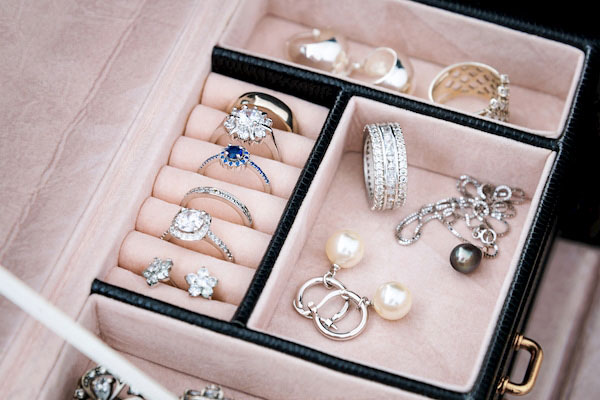
Care During Wear
- Put jewellery on last when getting ready - avoid letting your jewellery come into contact with make-up, hairspray, and perfume. This is the number one cause of damage and discolouration that we come across, and also the easiest to avoid!
- Take off jewellery when swimming, showering, or washing up - soaking and submerging in water can be damaging, especially in chlorine or cleaning chemicals.
- Remove jewellery when sleeping (chains and earrings can get tangled in hair).
- Take jewellery off when working with your hands, or where stones or metal might get knocked.
- Sweat can tarnish metal, and will cause a build-up of grime, so it’s advisable to remove any jewellery before taking part in sports activities. This will also remove any possibility of pieces getting knocked or broken!
- White gold jewellery gets its striking white colour from its rhodium plating, which can be affected by the chemicals and alcohol in hand sanitizer. To avoid this plating being stripped and making your jewellery look patchy, take off your rings when you’re being hygienic!
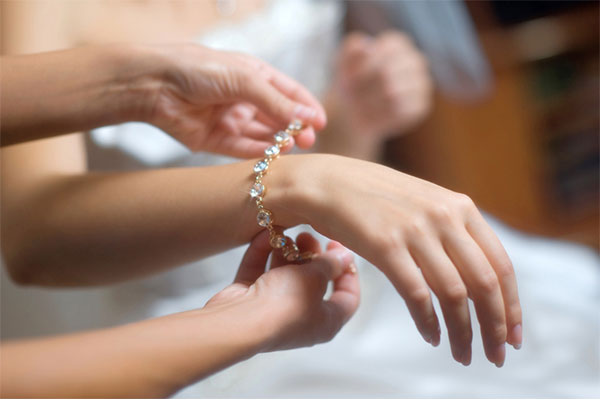
General Care Tips
- Ultrasonic cleaners are becoming a more and more popular method for cleaning jewellery - a small tank is filled with water and cleaning solution, your jewellery is placed inside, and high frequency vibrations lift dirt away. Use these with caution for more delicate pieces espcially older or antique jewellery that may need remedial repair work.
- Stronger pieces like diamond and gold, these cleaners should be used with caution on other stones, and avoided altogether with very delicate pieces of jewellery.
- For cleaning most types of jewellery, a mild washing up liquid solution is sufficient to remove dirt and grime. For really special pieces however, there are many brands of specialist solutions specifically formulated for individual metals or gemstones.
- Although regular cleaning at home will keep your pieces looking beautiful between wears, we recommend bringing your jewellery into your local jewellers yearly for a professional deep clean, when we also can also check for any damage to the settings, clasps, and stringing.
- Finally, enjoy wearing your jewellery! Certain metals and stones, such as pearls and sterling silver, benefit from regular wear to prevent tarnish, and so you should use every opportunity to show off your favourite bit of sparkle!
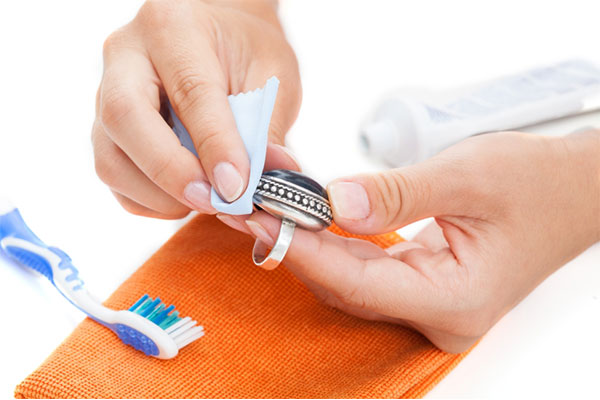
Yellow Gold
How Yellow Gold will wear
- Gold is the traditional metal for wedding bands, however pure gold is extremely soft and can be molded by hand. Gold used in jewellery is an alloy - it is combined with other metals to make it stronger. The higher the pure gold content (denoted in the carat number), the more easily the metal will be marked, and so for jewellery that will be worn often, a lower karat may be preferable.
- Gold is often used for jewellery that will be worn everyday, such as engagement rings and wedding bands, and so is susceptible to picking up daily grime and dirt - it will require regular cleaning to keep it looking its best.
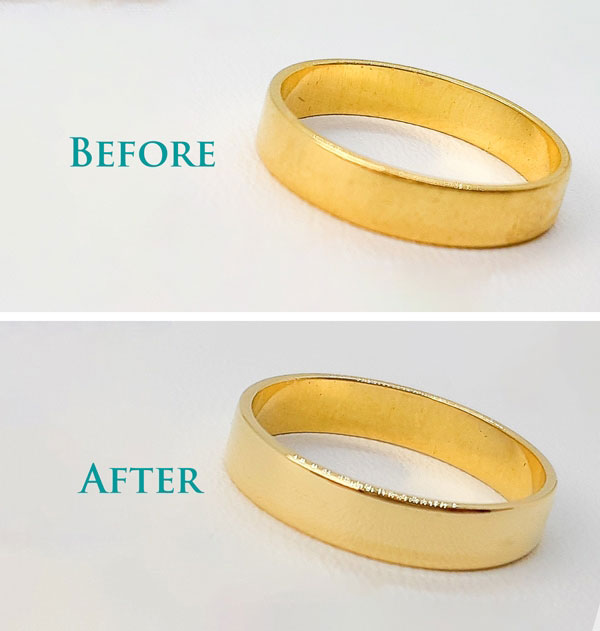
White Gold
How White Gold will wear
- Yellow gold can be polished to look as good as new, while white gold needs a slightly gentler touch.
- As pure gold is naturally yellow in colour, to create white gold, it is mixed with white alloys to make it whiter and then coated in rhodium to give it the reflective white sheen. Rhodium is a member of the platinum family so is very hard wearing, but over time the plating will wear off to reveal the slightly yellow tone underneath.
- To have the rhodium plating reapplied your jewellery will need to go to a workshop where they have the specialist equipment to re-plate.
How to clean Gold
- There are many different brands of specialist gold cleaning solutions on the market, but you can get a very good clean from just normal washing up liquid
- Add a few drops to a small bowl of luke-warm water, and leave to soak for 10 minutes. Remove from the water, and gently scrub with a soft bristled brush (a baby toothbrush works well) to clear any dirt particles - pay special attention to any gemstone settings and hard to reach cavities. Once cleaned, make sure to rinse your jewellery well (soap suds can leave a film which will dull the shine) and dry with a lint-free cloth.
- If your gold jewellery has any gemstones set into the metal, pay extra attention to the cleaning method - for example, you should avoid soaking pearl or opal in water, and so you should opt for a ‘dry-clean’ method instead - using a damp cloth or specialist jewellery cloth.
- If in any doubt on how to clean your jewellery, leave it to the professionals or seek advice before exposing it to any chemicals.
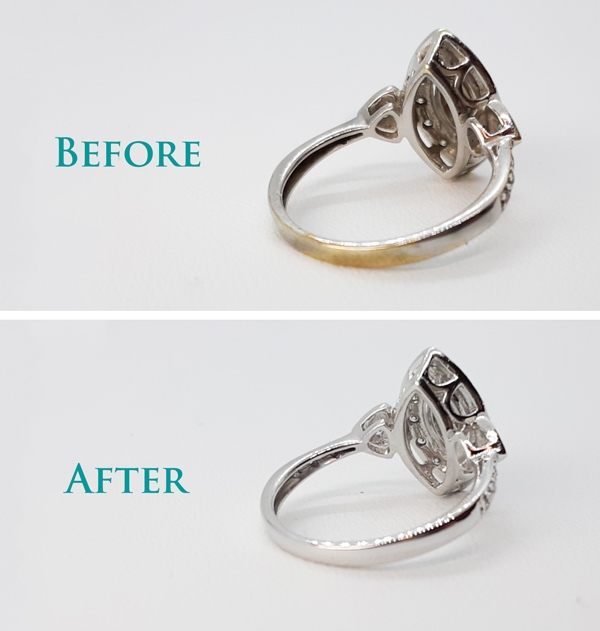
Platinum
How Platinum will wear
- Platinum’s strength, weight, and resistance to tarnish makes it a popular choice for daily wear. It is rarer, denser and heavier and more dense than gold, making it more expensive, but is a popular choice for men’s jewellery where it may be subject to more knocks and marks. With wear, platinum will develop an attractive silver-grey patina over time - this should be viewed as a sign of a well-loved piece of jewellery!
- Even though it is the hardest metal, it can and will scratch through daily wear and tear just like all the other metals, but unlike others it won’t tarnish or become discoloured.
How to clean Platinum
- Platinum can be cleaned with specialist cleaning solutions, or with a few drops of mild washing-up liquid in luke-warm water. Just leave to soak for a few minutes, gently lift any stubborn grime with a soft-bristled brush, rinse well in clean water, and dry thoroughly with a lint-free cloth.
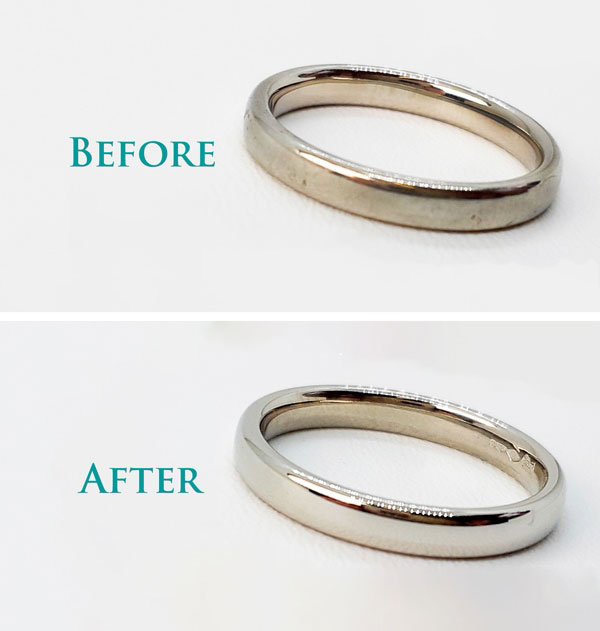
Diamond
How Diamond will wear
- The gemstone of choice for engagement rings, diamonds have an unrivalled level of sparkle. Of course, wearing your diamond jewellery every day will mean that the stone is exposed to the oils in your skin, dust in the air, and other substances such as soap and perfumes; all of these can contribute to dulling the brilliance of the diamond.
- Regular cleaning is essential to keeping your diamond jewellery looking its best - fortunately this is very easy to do at home!
How to clean Diamond
- Add a few drops of washing-up liquid to a small bowl of luke-warm water, and leave to soak for 10 minutes. Remove from the water, and gently scrub with a soft bristled brush (a toothbrush works well) to clear any dirt particles - pay special attention to any gemstone settings and hard to reach cavities.
- Once cleaned, make sure to rinse your jewellery well (remember, soap suds will leave a film) and dry with a lint-free cloth, taking care not to catch any claws on the cloth.
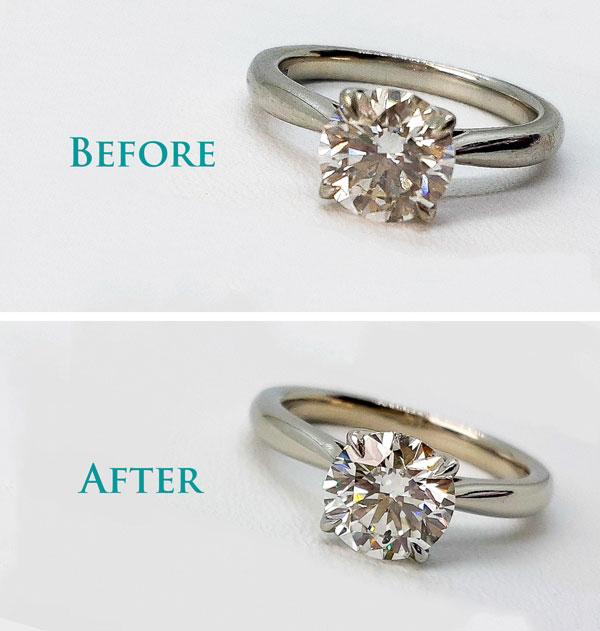
Gemstone
How Gemstone will wear
- There’s a gemstone for every colour of the rainbow, each with different chemical make-up which affects their strength and structure. The Mohs scale of hardness denotes how strong a stone is, and how well it will stand up to daily wear and tear.
- Pearls score quite low on the scale, while diamonds rank the highest, with every other gemstone landing somewhere in between. You can find out more about different gemstones hardness in our guide to birthstones.
How to clean Gemstone
- As some gemstones are more delicate than others, they require a softer touch when cleaning - pearl, opal, coral, amber, emerald, peridot and tanzanite can all be affected with dramatic changes in moisture and temperature, and so to avoid damaging the stone, a gentle wipe with a damp cloth is all that’s required.
- For stronger stones like rubies and sapphires, a brief soak in a mild washing up liquid solution, rinse, and dry should lift most grime - a small brush can be used to clean between setting and behind the stone.
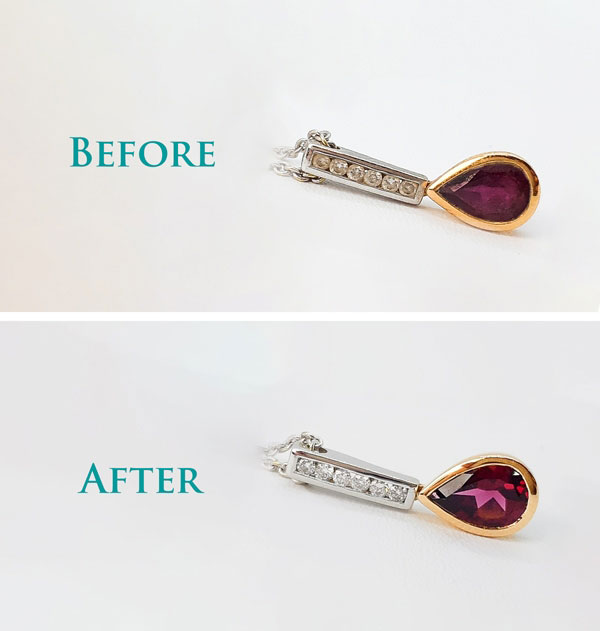
Pearl
How Pearl will wear
- Unlike many other gemstones, pearl is an organic material and require a little more care to keep them looking their best. Like all things, pearls do age, and over time their colour will change slightly as their natural composition changes.
- You will notice that older pearls (like those found in antique or heirloom pieces) have a yellow tinge - this should be seen as a sign of distinction and provenance; this colour change should only occur in real pearls, not artificial ones.
How to clean Pearl
- Pearls are porous, and so avoid submerging them in water or using any cleaning products - a gentle wipe with a slightly dampened cloth is all you need, followed by drying with a lint-free cloth.
- Try to keep your pearls away from perfumes and makeup as the lustre cannot be recreated.
- Pearls are traditionally strung on silk thread, and so to avoid this breaking, it’s important not to pull the string through the cloth when cleaning. It’s advisable to check this thread before each wear to check for any fraying, and take it to your jeweller annually for restringing - the last thing you want is for the string to break!
- If any parts of the silk thread are damaged, avoid wearing them until you can bring them to a jewellers to be restrung.
- Although pearls are one of the more delicate gemstones, this shouldn’t be a reason to relegate them to the bottom of the jewellery box. Much like sterling silver, pearls look their best when they’re worn often! The natural oils in your skin help to enhance the natural lustre and keep them looking beautiful.
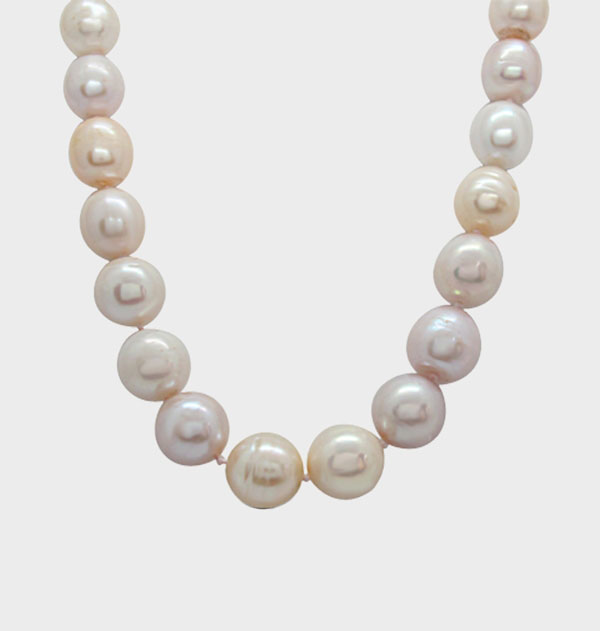
Silver
How Silver will wear
- Sterling silver is an alloy metal, meaning it contains 92.5% pure silver, mixed with 7.5% other metals (usually copper). When exposed to the air, these metals react and oxidise, causing a black coating to form, called tarnish. Fortunately, this doesn’t harm the silver metal underneath, and can be easily removed using a silver cleaning cloth or a silver jewellery dip for more intricate designs.
How to clean Silver
- Most silver polishing cloths work without the need for water - they are impregnated with an anti-tarnish solution which works instantly to remove the black coating and reveal the beautiful silver below. The cloth should turn black instead of the jewellery – and possibly your fingers too so be careful!
- Furthermore, when wearing your silver jewellery, the oils in your skin and the constant movement prevent the tarnish developing - all the more reason to wear your favourite pieces!
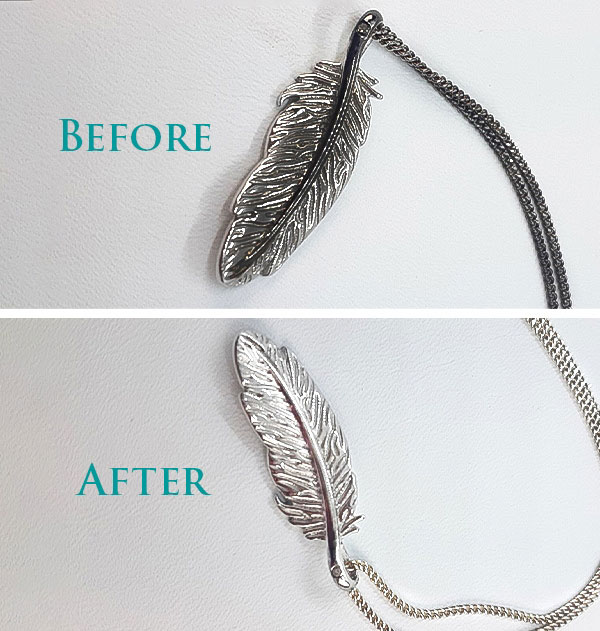
James Porter Jewellery
James Porter Jewellery
On all jewellery purchased in the James Porter store, a free lifetime clean and check is included as standard. We do recommend having your jewellery checked annually so that any issues which may arise can be caught early. As rings are worn daily, you may not be aware of slight knocks and dents so, feel free to call in to the James Porter Glasgow store any time to have your rings checked and cleaned at no extra charge.
We recommend replating rhodium on white gold as and when required - some may prefer replating their rings every 6 months, and others every 6 years. Replating goes to our local workshop and it will take a few working days for this work to be carried out.
James Porter’s local jewellery workshop can also repair and remodel older jewellery too. If you’re looking for old or damaged jewellery to be restored, we can provide you with an estimation to bring your piece back to its original beauty.
We can also provide estimates for any insurance work along with written estimates for insurance companies.
For restringing please call in to store where we can provide prices for any type of beaded necklace or bracelet to be restrung. From beads and synthetic stones, to cultured and precious gemstones - we can offer advice on the most suitable method of restringing for your jewellery pieces.
Valuation services can be offered on recent purchases in store at a standard flat fee, so long as the item of jewellery can be produced as well as a receipt no older than 5 years. For items not purchased from us or outside 5 years of purchase we can send away to be independently valued for a standard fee.
Get in touch
Get in touch
Contact us by phone at 0141 221 5855 or by email at [email protected]. We love our work and will be happy to help you with your query, we can also book a convenient time for a consultation to find the exactly what you need..
 Back to top
Back to top
 Basket
Basket





 0141 221 5855
0141 221 5855 Send us an email
Send us an email






 Secure payment methods
Secure payment methods


